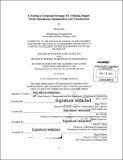Creating a corporate strategy for utilizing supply chain simulation, optimization and visualization
Author(s)
Chou, David (David Hancheng)
DownloadFull printable version (5.012Mb)
Other Contributors
Leaders for Global Operations Program.
Advisor
Edgar Blanco and Roy Welsch.
Terms of use
Metadata
Show full item recordAbstract
Computer based supply chain simulation, optimization, and visualization capability have changed significantly in the past 45 years, expanding capability in lockstep with increases in computational power. The increase in accessibility of relatively cheap and powerful hardware has led to the development of a multitude of supply chain simulation, optimization, and visualization programs catered towards reducing corporate supply chain costs. Some of these programs are commercial business to business offerings, while a significant set are developed internally within the corporation. Expertise in this field is increasingly seen as an area of competitive advantage for modern goods based corporations. However, the danger lies in executing decisions based upon inaccurate simulation results, often meaning millions of dollars lost in waste rather than the desired savings. This thesis aims to identify the needs of a corporation regarding supply chain simulation, optimization, and visualization - particularly how a company may categorize offerings within this field - how these programs may fit within the organizational context of a company, and how to ensure correct utilization of a set of supply chain programs. Supply chain is very well understood, but little focus has been placed on correctly utilizing these programs to support success for a company's goal of becoming operationally efficient. A current state analysis of a major U.S. manufacturing company, Caterpillar, Inc., was conducted and a new framework was applied to understand Caterpillar's usage of supply chain programs. This thesis utilizes findings from Caterpillar as a sample case to reinforce research. An overall strategy is developed based on research at Caterpillar, and supports the creation of a group of internal experts disassociated from specific supply chain specialties, such as procurement or logistics, in order to ensure global efficiency. A generic strategy is presented for any corporation utilizing computer based supply chain simulation, optimization, and visualization.
Description
Thesis: M.B.A., Massachusetts Institute of Technology, Sloan School of Management, 2014. In conjunction with the Leaders for Global Operations Program at MIT. Thesis: S.M., Massachusetts Institute of Technology, Department of Mechanical Engineering, 2014. In conjunction with the Leaders for Global Operations Program at MIT. 14 Cataloged from PDF version of thesis. Includes bibliographical references (page 46).
Date issued
2014Department
Leaders for Global Operations Program at MIT; Massachusetts Institute of Technology. Department of Mechanical Engineering; Sloan School of ManagementPublisher
Massachusetts Institute of Technology
Keywords
Sloan School of Management., Mechanical Engineering., Leaders for Global Operations Program.